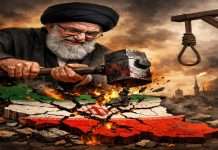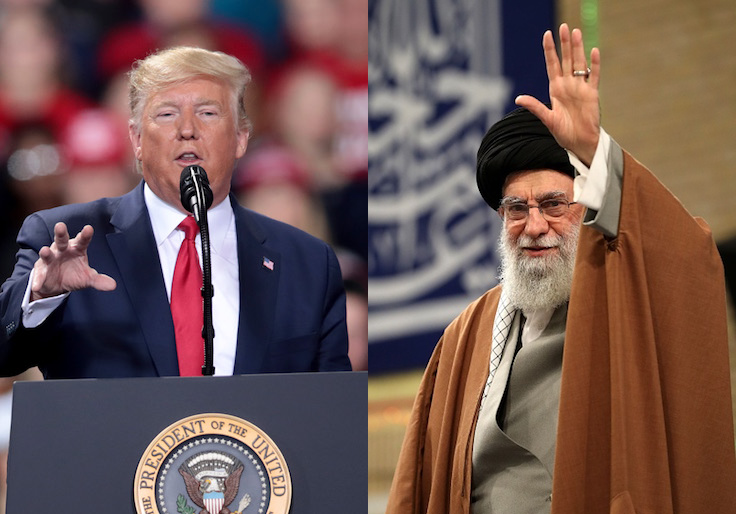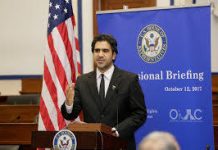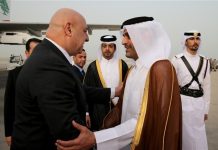فخُّ إيران الجديد مقابل فرصة ترامب التاريخية لتغيير الشرق الأوسط
د. ماجد رافي زاده/معهد جيتستون/12 تموز 2025
(ترجمة من الإنكليزية بتصرف بواسطة الياس بجاني بالإستعانة بمواقع ترجمة الكترونية متعددة)
Iran’s New Trap vs. Trump’s Once-in-a-Lifetime Chance to Transform the Middle East
Dr. Majid Rafizadeh/Gatestone Institute/July 12/2025
President Donald J. Trump, through a bold and unapologetic foreign policy, has emerged in just a few short months, as the only leader in recent history capable of reshaping the region and challenging Iran’s theocratic dictatorship with real consequences. His actions have already produced historic results…
If Trump settles into believing that setting back Iran’s nuclear program by a few years is enough, the world will soon fall into the very trap that Tehran has set. The regime will rebuild, rearm, and reemerge stronger, angrier, and even nearer to having its bomb. The world will then once again face the prospect of a nuclear-armed Iran—with perhaps no leader to stop it.
Now is not the time to offer the regime a lifeline in the form of negotiations or sanctions relief. The regime will doubtless try its old tricks—sending diplomats to Western capitals, promising temporary compliance, and begging for centrifuges for “peaceful energy” and a new “deal.” This is a trap
Any deal now will not benefit the United States. It will only help the Iranian regime recover, rebuild its economy, and ultimately return to its path of terror. The time has come to “finish the job.” The Iranian regime must not be allowed to survive long enough to recover. The goal is not to delay the problem but to solve it.
President Donald J. Trump, through a bold and unapologetic foreign policy, has emerged in just a few short months, as the only leader in recent history capable of reshaping the region and challenging Iran’s theocratic dictatorship with real consequences. His actions have already produced historic results.
It took decades — across multiple presidencies, wars, and failed negotiations — before the United States finally had a president who understood, with both clarity and conviction, how to confront the Iranian regime and transform the trajectory of the Middle East. President Donald J. Trump, through a bold and unapologetic foreign policy, has emerged in just a few short months, as the only leader in recent history capable of reshaping the region and challenging Iran’s theocratic dictatorship with real consequences. His actions have already produced historic results — from crippling the regime’s nuclear infrastructure to fostering unprecedented peace deals.
The work, however, is not yet finished. It is imperative now to push forward and seize the opportunity to dismantle Iran’s threat permanently. A stable and peaceful Middle East could very well be one of the most enduring legacies of Trump’s leadership, one that generations of Americans and Middle Easterners will remember as the moment that Trump turned history from a global threat into a “Golden Age,” for the world.
That cannot be done, regrettably, with these fundamentalist fanatics still ruling Iran.
Trump’s approach to Iran has been fundamentally different from that of his predecessors. Where others saw conciliation, he saw manipulation. Where others offered concessions, he applied pressure. While many administrations talked about Iran’s nuclear threat, Trump acted. In his previous term, he withdrew America from a disastrous Iran nuclear deal that enabled Iran to have as many nuclear weapons as it liked along with the intercontinental ballistic missiles to deliver them – beginning this October! Trump began by initiating tough sanctions to choke off the Iranian regime’s financial lifeline. In his second term, he went even further, authorizing precision military strikes that hit Iran’s deeply buried nuclear facilities in Fordow as well as Natanz and Isfahan. These were not symbolic gestures. According to U.S. defense and intelligence assessments, Iran’s nuclear program has been set back by possibly two years. That is not just a delay—it was a disruption of Iran’s most dangerous ambitions.
While the strikes slowed Iran down, unfortunately, they did not end the threat. The Iranian regime, driven by a deeply entrenched theocratic ideology, is determined. It has already started to excavate the sites that were hit. Iran’s leaders are likely banking on the hope that Trump will eventually leave office and a more lenient administration will take over—one that it can manipulate as it has done in the past. If Trump settles into believing that setting back Iran’s nuclear program by a few years is enough, the world will soon fall into the very trap that Tehran has set. The regime will rebuild, rearm, and reemerge stronger, angrier, and even nearer to having its bomb. The world will then once again face the prospect of a nuclear-armed Iran—with perhaps no leader to stop it.
This regime will not be passively waiting. It will be aggressively forging deeper military and strategic partnerships with hostile regimes such as North Korea, China, and Russia. These alliances can provide it with weapons, intelligence, and black-market nuclear technology. The longer the world waits, the more entrenched these partnerships become. That is why the notion of “waiting Iran out” is not only naive—it is potentially catastrophic. Trump understands this. He has never viewed Iran as a conventional adversary to be negotiated with, but as a revolutionary regime that must be weakened and contained.
What then must be done? First, the “maximum pressure” economic pressure — including secondary sanctions: countries that do business with Iran are barred from doing business with the U.S. — must continue and intensify. The Trump administration has already imposed some of the toughest sanctions possible on Iran by targeting its oil exports, financial institutions, and affiliates such as Hezbollah. Iran’s economy is shrinking. Its currency is collapsing. Now is not the time to offer the regime a lifeline in the form of negotiations or sanctions relief. The regime will doubtless try its old tricks—sending diplomats to Western capitals, promising temporary compliance, and begging for centrifuges for “peaceful energy” and a new “deal.” This is a trap
Every previous deal with Iran has only allowed the regime to catch its breath, regroup, and resume its pursuit of nuclear weapons with renewed vigor. Trump knows this. Any deal now will not benefit the United States. It will only help the Iranian regime recover, rebuild its economy, and ultimately return to its path of terror. The time has come to finish the job.
In addition to economic pressure, sustained military readiness is essential. Trump’s policy has always involved using force not as a first resort, but as a clear and credible deterrent. This deterrence must remain in place. If Iran attempts to resume any enrichment or rebuild previously destroyed nuclear sites, there must be swift and decisive military consequences. This should not be done in isolation. Cooperation with Israel—America’s most important ally in the region— needs to be further strengthened and deepened. Israel has shown that it can penetrate Iran’s airspace, gather intelligence, and execute precise operations. To maintain this superiority, Israel must be fully supported. This backing should include providing Israel with advanced weaponry, intelligence, and bunker-busting bombs capable of destroying underground nuclear sites. Air dominance is key. President Trump together with Israel need to create a future where deterrence is truly effective and the Iranian regime cannot even contemplate hiding a nuclear program underground.
At the same time, Trump’s Middle East strategy needs to include building coalitions and alliances that further isolate the Iranian regime. Trump’s trailblazing Abraham Accords—a set of normalization agreements between Israel and Arab nations—represented a historic breakthrough that eluded presidents for decades. These Accords, by attempting to bring former enemies together in a shared vision of stability and economic cooperation, shifted the geopolitical map of the Middle East. Under Trump’s leadership, the possibility of expanding the Accords to include more nations—even those previously aligned against Israel—is real. He has already initiated outreach toward countries such as Saudi Arabia, Oman, and even Syria, thereby forging diplomatic paths that could create a united regional front. Such a coalition would not only serve to contain Iran’s influence but also to lay the foundation for a new Middle East order—one built not on conflict and chaos, but on mutual security and partnership. None of this would be possible without the Trump’s leadership. While others have wavered and delivered platitudes, he has acted and delivered results. In half a year back in office, he has done more to dismantle Iran’s nuclear ambitions than most of his predecessors did in two full terms.
Trump has halted Iran’s momentum, disrupted its plans, and signaled that the era of American appeasement and weakness is over. The window of opportunity is open. \ If the current momentum is maintained, the United States and its allies can do more than delay Iran’s nuclear program. They can end it for good. They can hasten the fall of a regime that threatens not only Israel, but also the Sunni Gulf States, the United States, former Trump officials and dissidents and that terrorizes, imprisons, tortures and executes its own people and has destabilized the region for 46 years. Trump, after two assassination attempts, has a bounty on his head of $21 million. Trump has reshaped the Middle East in ways that were once considered unimaginable. Through strength, resolve, and vision, he has brought America closer to achieving one of its most elusive foreign policy goals: a peaceful and secure Middle East, free from the shadow of Iran’s nuclear threat and theocratic tyranny. This legacy, however, can only endure if it is seen through to completion. The Iranian regime must not be allowed to survive long enough to recover. The goal is not to delay the problem, but to solve it. With Trump in office, the chance to “finish the job” has finally arrived. It may never come again.
*Dr. Majid Rafizadeh, is a political scientist, Harvard-educated analyst, and board member of Harvard International Review. He has authored several books on the US foreign policy. He can be reached at dr.rafizadeh@post.harvard.edu
*Follow Majid Rafizadeh on X (formerly Twitter)
https://www.gatestoneinstitute.org/21736/trump-iran-transform-middle-east




















